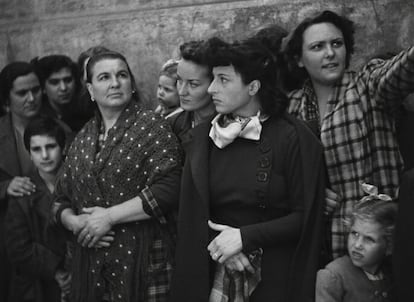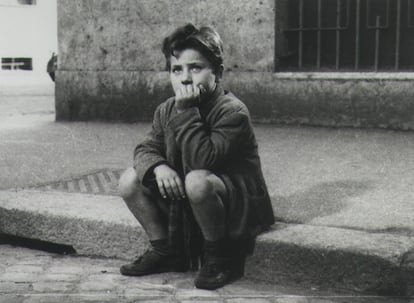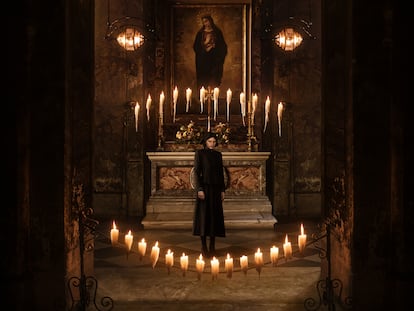Neorealism: What remains of the movement that changed world cinema, but couldn’t change Italy?
The success of the movie ‘There’s Still Tomorrow’ is fueling renewed interest in the creative phenomenon that took place during the country’s tragic times in the final days of World War II

In contrast to other great artistic movements, like the innovative, even revolutionary currents of nouvelle vague and British free cinema, neorealism was unplanned. Vittorio De Sica, Roberto Rossellini, Federico Fellini, Cesare Zavattini and Luchino Visconti never met in a publication’s editorial office or in a Tastevere trattoria to map out their artistic, social and political assault. But such was the case in England when Lindsay Anderson, Tony Richardson, Karel Reisz and their ilk, angry young people who would up filming the kitchen sink of their country’s kitchens, went so far as to write a manifesto of their cinematic intent. So too did Claude Chabrol, Alain Resnais, Jean-Luc Godard, François Truffaut and Jacques Rivette, whose ideology took shape under the auspices of the Cahiers du Cinéma magazine.
Neorealism was not constructed; it emerged. Neorealism was not planned, it simply sprouted, thanks to (or because of) a series of political, social and industrial circumstances, all of them tragic, that took place in the final days of World War II, during the decline of Mussolini’s fascism and amid the economic and moral poverty of a collapsed country. It was then, between 1943 and 1948, that a handful of directors created a series of wonderful films that seemed to speak of the same subject in a similar manner: of the sacrifices of the people, using children as observers of the difficulties of their elders’ lives, the portrayal of sexual desire previously forbidden by fascist censorship, the ethical cataclysm in the minds of citizens who, stuck between hunger and desolation, were profoundly discombobulated after either resisting or collaborating with Nazi power. When Rome, Open City was released in 1945, Life magazine said that the film helped Italy to begin to recover the nobility it had lost during Mussolini’s rule. It was precisely this work by Rossellini that led to the term “neorealist,” coined by a critic named Umberto Barbaro to describe films like it and De Sica’s Shoeshine and The Bicycle Thief, Rossellini’s Paisan and Germany, Year Zero and Visconti’s The Earth Trembles. Historic works that, still, seem to have no unifying style, given that some were closer to documentary works and others dedicated to the search for truth via fiction.

Due to all of this, to speak of neorealism, perhaps, hints at fallacy. Or perhaps not. What is left of the movement that provided a radiography of its country, later transformed world cinema with its technique and substance, but failed to change Italy itself, which since those days has largely remained immersed in nearly perpetual political crisis? The question seems timely because people are once again talking about neorealism after the international premiere of Italian blockbuster There’s Still Tomorrow, directed by actress Paola Cortellesi (and which was seen by more than five million people in its home country; not to mention by over 150,000 and counting in Spain after two months in theaters). This renewed interest is also linked to the fact that the severe, devastating, yet beautiful Rome, Open City and Germany, Year Zero are now playing in United Kingdom and Ireland movie theaters.

Of course, if any film has revived neorealism’s legacy, it’s likely not There’s Still Tomorrow, a popular film in every sense of the word and one that possesses many virtues, but that could almost be considered the movement’s antithesis, despite its black and white aesthetic and post-war setting, its violence against women conveyed through dance, its surprisingly dramatic finale, its melodramatic touch, and its light humor’s certain schematism. “When someone, be it the public, the state or the church says, ‘Enough of poverty, enough of films that reflect poverty,’ they commit a moral crime. They refuse to understand, to learn. And by not wanting to learn, consciously or not, they rob from reality,” says Cesare Zavattini, one of the primary screenwriters from the neorealism movement, whose auteurs lugged cameras into the open air, their studios destroyed, capturing the ruins of their cities’ streets and buildings. The filmmakers frequently used amateur performers, and openly critiqued the indifference of authorities, centralizing the transition from the individual to the collective.
In Italy, neorealism began to flag and transform after 1948, following the arrival of the Christian Democrats to power and the birth of more commercial cinema thanks to the government’s ministry of cinematography, led by the soon-to-be famous Giulio Andreotti. Thus, the beautiful austerity of works like The Bicycle Thief was replaced by a touch of artifice, as in Two Women (1961), to name two titles by the same director, De Sica, in which this evolution is noticeable. Of course, neorealism carried on in films like Visconti’s Rocco and His Brothers (1960) and even in the thought-provoking pink neorealism, unjustly lambasted in its day by some critics due to its crime of introducing comedy into the search for truth. This, despite the fact that works by filmmakers like Mario Monicelli and Luigi Comincini (The Great War and Everybody Go Home) could be as rough or rougher, even with the laughs, than some of their predecessors.
Meanwhile, neorealism’s influence on films around the world was staggering. In India, its pull could be seen in the work of Satyajit Ray and his Apu trilogy. The same could be said in much of new cinema, from Asia to Europe to Brazil. In Italy itself as well, as in the work of the Taviani brothers and Ermanno Olmi. Certainly, in the 1970s new Hollywood, primarily in the Jerry Schatzberg of Scarecrow and The Panic in Needle Park. And even in Spain, despite dictatorial censorship, in works like Furrows (1951) by José Antonio Nieves Conde. More than three decades of neorealist influence can be detected across countries and historic periods, through collapse and various attempts and moral rearmament.
Where might one locate the neorealism footprint in today’s films? Well, not in any current black-and-white movie addressing Italian reality. Nor in the gaze of bourgeois remorse that seems to guide Alfonso Cuarón’s Roma, which was also described as neorealist. These projects don’t speak to the movement’s essence. Its key lies in films that provoke, in their respective countries, phrases like the one uttered by Andreotti after the premiere of De Sica’s overwhelming Umberto D. (1952): “Dirty laundry is cleaned at home, not aired outside.” Or in the best films of China’s Jia Zhangke (Pickpocket, Unknown Pleasures, Ash is Purest White); in the work of Abbas Kiarostami and his followers in Iran; in Andrei Zvyagintsev and his chilling vision of contemporary Russa in Leviathan; in the Italian Gianfranco Rosi’s documentaries Sacro GRA and Fire at the Sea; on poverty in Rome’s peripheral neighborhoods and the horror experienced by refugees on the island of Lampedusa.
Resistance, renewed struggle. Sans apriorism, sans dogma, sans condescension, sans (excessive) formalism. Approached in an open manner, critically, always on the path to authenticity. In the words of De Sica, “Neorealism was born in us, in our spirit, in the need to express ourselves in a way that was different from what fascism and a certain type of American cinema forced upon us.”
Sign up for our weekly newsletter to get more English-language news coverage from EL PAÍS USA Edition
Tu suscripción se está usando en otro dispositivo
¿Quieres añadir otro usuario a tu suscripción?
Si continúas leyendo en este dispositivo, no se podrá leer en el otro.
FlechaTu suscripción se está usando en otro dispositivo y solo puedes acceder a EL PAÍS desde un dispositivo a la vez.
Si quieres compartir tu cuenta, cambia tu suscripción a la modalidad Premium, así podrás añadir otro usuario. Cada uno accederá con su propia cuenta de email, lo que os permitirá personalizar vuestra experiencia en EL PAÍS.
¿Tienes una suscripción de empresa? Accede aquí para contratar más cuentas.
En el caso de no saber quién está usando tu cuenta, te recomendamos cambiar tu contraseña aquí.
Si decides continuar compartiendo tu cuenta, este mensaje se mostrará en tu dispositivo y en el de la otra persona que está usando tu cuenta de forma indefinida, afectando a tu experiencia de lectura. Puedes consultar aquí los términos y condiciones de la suscripción digital.
More information
Archived In
Últimas noticias
Most viewed
- Sinaloa Cartel war is taking its toll on Los Chapitos
- Oona Chaplin: ‘I told James Cameron that I was living in a treehouse and starting a permaculture project with a friend’
- Reinhard Genzel, Nobel laureate in physics: ‘One-minute videos will never give you the truth’
- Why the price of coffee has skyrocketed: from Brazilian plantations to specialty coffee houses
- Silver prices are going crazy: This is what’s fueling the rally











































